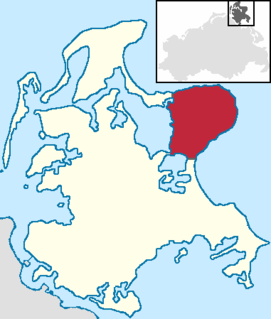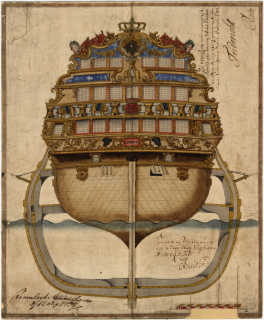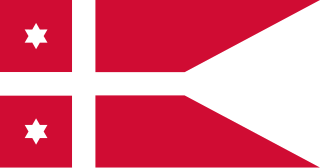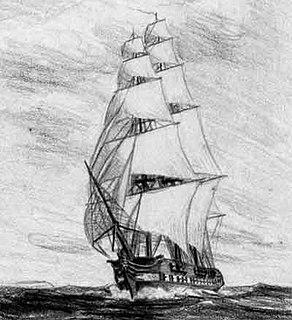Søehesten was an 18-gun barge of the Royal Dano-Norwegian Navy, commissioned in 1795. During the Battle of Copenhagen on 2 April 1801, it was commanded by Lieutenant B. U. Middelboe with a complement of 178 sailors. 12 of the ship's crew were killed in the battle, and 21 wounded. The ship struck its colours at 14.30.

HDMS Najaden was a frigate of the Royal Dano-Norwegian Navy, which she served from 1796 until the British captured her in 1807. While in Dano-Norwegian service she participated in an action at Tripoli, North Africa. She served the Royal Navy as the fifth rate HMS Nyaden from 1808 until 1812 when she was broken up. During her brief British service she participated in some small attacks in the Barents Sea during the Anglo-Russian War.

The Sophia Amalia was a ship of the Royal Dano-Norwegian Navy named after Sophia Amalia, the wife of King Frederick III.
HMS Dictator was a 64-gun third-rate ship of the line of the Royal Navy, launched on 6 January 1783 at Limehouse. She was converted into a troopship in 1798, and broken up in 1817.
The Admiral Danish Fleet (ADMDANFLT) was the operationally supreme organisation of the Royal Danish Navy between 1 January 1991 and 30 September 2014.

The Battle of Saltholm was fought on 9 June 1808 during the Gunboat War. Danish and Norwegian ships attacked a British convoy off the island of Saltholm in Øresund Strait near Copenhagen.
HDMS Lolland was launched in March 1810. She served in at least four major engagements during the Gunboat War before she was transferred to the Norwegian navy after the Treaty of Kiel brought about the separation of Norway from Denmark in 1814. Lolland continued to serve with the Norwegian Navy until sold in 1847.
The brig HDMS Langeland, launched in late 1808 and fitted out in 1809, was one of four brigs transferred to Norwegian ports from Denmark on 1 January 1810. From Norway she escorted Danish cargoes or harried enemy (British) merchant shipping. She took part in a successful cruise to the North Cape along with the brig Lougen in 1810 and was later taken into the fledgling Norwegian navy after the 1814 Treaty of Kiel. She was sold into merchant service in 1827.

Battle of Rügen was a major naval battle fought on August 8, 1715 off Jasmund on the Swedish island of Rügen during the Great Northern War.

HDMS Elephanten was a ship of the line of the Royal Dano-Norwegian Navy that served from 1703 to 1728. There were three other Danish ships-of-the line of the same name, dating from 1684, 1741 and 1773. The ship was sometimes referred to as Nye Elefant to differentiate from others of similar name. For much of her service career, which coincided with the Great Northern War, Elephanten was the flagship of the Danish fleet active in the Baltic Sea.

The Chief of the Royal Danish Navy is the professional head of the Royal Danish Navy. The current Chief of the Naval Command is Rear admiral Torben Mikkelsen.

HDMS Bellona was a frigate of the Royal Danish Navy, which she served from 1835 to 1862.
HDMS Friderichsværn was a Danish frigate built at Nyeholm, Copenhagen, in 1783. The British Royal Navy captured her in 1807 and took her into service as HMS Frederickscoarn. It sold her in 1814.
Henrik Lorentz Fisker was a successful naval officer in the service of Denmark. He was the son of an attorney at the supreme court, and deputy mayor of Copenhagen. From the age of thirteen as a cadet in the Danish-Norwegian navy, he rose through the ranks to vice admiral in 1775 and full admiral in 1790. He died 20 June 1797 and was buried in the Holmens Kirkegård, the Danish naval cemetery, in Copenhagen.
HDMS Hvide Ørn , was a light frigate designed by Frantz Hohlenberg and built in Copenhagen. She capsized and was lost with all hands off Corsica at the end of 1799. There were three previous ships bearing this name in the Danish navy. The name was after the loss of the ship retired. An 1898 model of the ship is in the collection of the Royal Danish Naval Museum.
HDMS Ørnen (1694) was a frigate in the Royal Danish Navy active during the Great Northern War
Bendix Lasson Bille was a naval officer and rear admiral in the service of the Danish crown.
HDMS Det Store Bælt (1782) later called Holsten (I), was a Danish frigate.
HDMS Nidelven was a brig launched at Copenhagen on 1 December 1792. She was present at both British attacks on Copenhagen, and the British Royal Navy seized her at Copenhagen on 7 September 1807 at the surrender of Copenhagen. The British took her into service as HMS Nid Elven. She served between 1808 and 1809, during which time she captured a small French privateer. She was laid up in 1809. The Navy sold her in 1814.

HDMS Justitia was a Royal Dano-Norwegian Navy ship-of-the-line, built to a design by Henrik Gerner. Although launched in 1777, she was not fully commissioned until 1780. The British Royal Navy seized her in 1807, together with the rest of the Danish fleet after the second battle of Copenhagen. The British never commissioned Justitia. A renaming to Orford in 1809 was cancelled. She was broken up in 1817.







